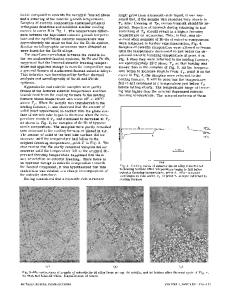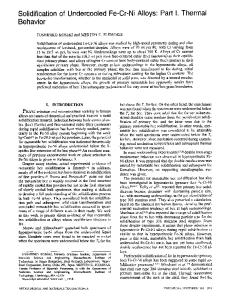Solidification Mechanism of Highly Undercooled Metal Alloys
- PDF / 1,088,509 Bytes
- 5 Pages / 417.6 x 639 pts Page_size
- 66 Downloads / 365 Views
65
SOLIDIFICATION MECHANISM OF HIGHLY UNDERCOOLED METAL ALLOYS YUH SHIOHARA, MEN G. CHU, DAVID G. MACISAAC AND MERTON C. FLEMINGS M.I.T., 77 Massachusetts Avenue, Cambridge, Massachusetts, USA
ABSTRACT This paper describes the results of experiments on metal droplet undercooling, and presents a preliminary analysis of the structures obtained. Work was conducted with Sn-25wt%Pb and Ni-34wt%Sn alloys. To achieve the required high degrees of undercooling, emulsification treatments were utilized following techniques described by Perepezko and co-workers. Experiments show the fraction of supersaturated primary phase is found to be a function of the amount of undercooling, as is the fineness of the structures. The solidification behavior of the tin-lead droplets during recalescence was analyzed using three different hypotheses; 1) solid forming throughout recalescence is of the maximum thermodynamically stable composition, 2) partitionless solidification below the "To" temperature, and solid forming thereafter is of the maximum thermodynamically stable composition, and 3) partitionless solidification below the "To" temperature with solid forming thereafter that is of the maximum thermodynamically metastable composition that is possible.
INTRODUCTION Undercooling of liquid metal is a common phenomenon, but the amount of undercooling is usually restricted by the presence of heterogeneous nucleation catalysts. The homogeneous and heterogeneous nucleation theory was first applied to metallic systems by Turnbull and his co-workers [1]. The critical (maximum) undercoolings obtained were approximately equivalent to 0.18 Tm, where T m is the melting point of the metal in the absolute temperature scale. Recently, the droplet technique has been modified and improved by Perepezko, Loper and co-workers [2,3]. Finely dispersed droplets of low melting temperature alloys, emulsified in an organic oil, have shown undercoolings in excess of 0.3 Tm prior to nucleation. In this work, high undercoolings were generated by the emulsification method and resulting microsegregation and the microstructure studied in Sn25wt%Pb alloy. The technique was also extended for the first time to a high melting point nickel base alloy. EXPERIMENTAL PROCEDURE The tin-lead alloy was prepared in a vacuum melter from high purity (99.9999%) metals. Droplet dispersions of the alloy were produced in a resistance furnace by emulsifying a mixture of liquid metal and organic carrier fluid (Polyphenyl-ether), contained a Pyrex crucible, with a high speed (3800 rpm) shearing device. The atmosphere in the furnace was purged with pure argon gas. Residual amounts of oxygen in the presence of isophthalic acid served as an oxidant to produce a thin oxide surface film, which prevents the
66 droplets from agglomerating. The temperature was kept at 25%C above the melting point during shearing, which continued for 40 minutes, producing fine droplets dispersed in the oil. The emulsified samples were transferred to sealed aluminum pans for analysis in a differential thermal a
Data Loading...










